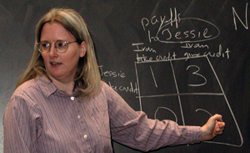 |
| Haverford mathematician Lynne Butler described how understanding John Nash’s equalibria theory can benefit those engaged in artistic collaboration. |
11:15 a.m., Nov. 18, 2002--Lynne Butler, professor of mathematics at Haverford College, has studied the life and theories of mathematician John Nash, the 1994 Nobel Prize winner in mathematics and the subject of the movie, “A Beautiful Mind.” Like Nash, Butler’s brother has lived with schizophrenia for 30 years.
Butler spoke at UD, Tuesday, Nov 12, to the art department’s Visual Communications Group, about Nash, his foundational theory of non-cooperative games and how the theory applies to artistic collaboration.
In “A Beautiful Mind,” Nash is at a bar with a group of friends when he begins to develop the theory of what is now called Nash equalibria, the idea that won him the Nobel Prize and the respect of his colleagues and loved ones, despite his schizophrenia.
At the bar, he and his friends begin to compete for a beautiful blonde in a group of five women. “If we all go for the blonde,” Nash says, “we block each other, not a single one of us is going to get her…and we insult the other girls. But, what if no one goes for the blonde. We don’t get in each other’s way, we don’t insult the other girls. It’s the only way to win….the best result comes from everyone in the room doing what’s best for himself and the group.”
Butler’s web site [www.haverford.edu/math/lbutler.html] has a review of “A Beautiful Mind” that she wrote for the April 2002 issue of “Notices of the American Mathematical Society.”
Realizing that the mathematicians’ theory has direct application to artistic collaboration, Ray Nichols, director of Visual Communications, invited Butler who has studied Nashs’ theory, to speak at UD.
Before joining the Haverford faculty in 1991, Butler was an assistant professor of mathematics at Princeton and a postdoctoral fellow at the Institute for Mathematics and Its Applications. She attended college at the University of Chicago and graduate school at the Massachusetts Institute of Technology, where she earned her Ph.D. in mathematics. Butler's research centers on enumerative and algebraic combinatorics.
Article by Barbara Garrison
Photo by Duane Perry
|

